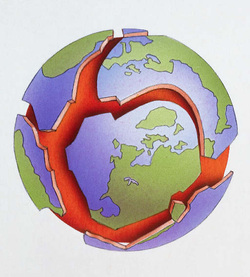The Theory of Plate Tectonics

- Plate tectonics is a theory that explains movement, seismicity, volcanism, continental drift, and mountain formations.
- The theory of plate tectonics has equivalently done great for geology what Charles Darwin's theory of evolution did for biology.
- The theory states that the Earth's lithosphere is broken into 7 large, rigid pieces called plates.
1) African
2) North American
3) South American
4) Eurasia
5) Indo-Australian
6) Antarctic
7) Pacific
- A few other minor plates exist including the Arabian, Nazca, and Philippines plates.
- The plates all move in different directions at speeds from 2 cm to 10 cm per year.


